Discover Florida Nature
It's time to explore the natural Florida


|
|
|
|
|
Beetles are common insects with a shell like exterior. They differ from
all other winged insects by having the first pair of wings hardened and
thickened. These hard forewings serve as a protective shield for the
fragile flying wings. Be sure and check out
our video showing
a dung beetle hard at work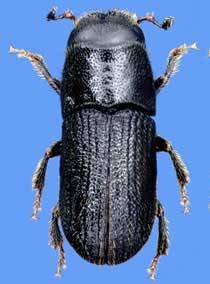 Southern
Pine Beetle- The Southern Pine Beetle (SPB) is one of five
common species of pine bark beetles that occur throughout the
Southeastern United States. Pine bark beetles utilize stressed, dying,
or recently-dead pines as hosts. All species tunnel, reproduce, and feed
in the inner bark or phloem (located between the outer bark and the
wood); this activity disables the transport of sugars through the
tree. Adults are 2 to 4 mm in length, short-legged, cylindrical and
brown to black in color. The broad and prominent head has a distinct
notch or frontal groove on male beetles. The rear end or abdomen of
adults is rounded. New adults progressively change in color from
yellowish-white to yellowish-brown to reddish-brown to finally become
dark brown. The southern pine beetle is the most destructive insect pest
of pine in the southern United States. Southern
Pine Beetle- The Southern Pine Beetle (SPB) is one of five
common species of pine bark beetles that occur throughout the
Southeastern United States. Pine bark beetles utilize stressed, dying,
or recently-dead pines as hosts. All species tunnel, reproduce, and feed
in the inner bark or phloem (located between the outer bark and the
wood); this activity disables the transport of sugars through the
tree. Adults are 2 to 4 mm in length, short-legged, cylindrical and
brown to black in color. The broad and prominent head has a distinct
notch or frontal groove on male beetles. The rear end or abdomen of
adults is rounded. New adults progressively change in color from
yellowish-white to yellowish-brown to reddish-brown to finally become
dark brown. The southern pine beetle is the most destructive insect pest
of pine in the southern United States.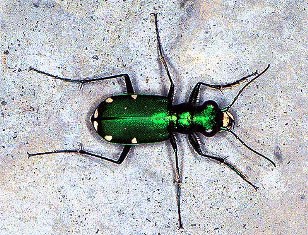 Tiger
Beetles-
As their name implies, Tiger Beetles are active, agile insects, quick to
take flight, possessing good vision, and in many cases, having colorful
patterns which are quite attractive. Tiger beetles are predators,
feeding on insects they are able to capture with their mandibles. It is
common to collect adult beetles with ant heads still attached to a
variety of appendages! Rather than specializing on certain species for
prey, adults are opportunistic feeders. Adult tiger beetles are about
1/2- inch long and have long antennae and legs. They differ from ground
beetles in that the head is wider than the thorax. Common species are
grayish brown to black with white spots and markings on the wing covers.
Some species have metallic or iridescent blue, green and bronze
coloration. Adults of species are identified by distinguishing
characters that include presence of hairs on the face of the head as
well as the pattern and texture of the wing covers. Tiger beetles are
closely related to ground beetles. Tiger
Beetles-
As their name implies, Tiger Beetles are active, agile insects, quick to
take flight, possessing good vision, and in many cases, having colorful
patterns which are quite attractive. Tiger beetles are predators,
feeding on insects they are able to capture with their mandibles. It is
common to collect adult beetles with ant heads still attached to a
variety of appendages! Rather than specializing on certain species for
prey, adults are opportunistic feeders. Adult tiger beetles are about
1/2- inch long and have long antennae and legs. They differ from ground
beetles in that the head is wider than the thorax. Common species are
grayish brown to black with white spots and markings on the wing covers.
Some species have metallic or iridescent blue, green and bronze
coloration. Adults of species are identified by distinguishing
characters that include presence of hairs on the face of the head as
well as the pattern and texture of the wing covers. Tiger beetles are
closely related to ground beetles.
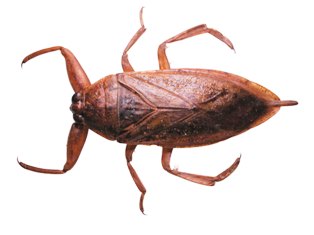 Giant
Waterbug-
The Giant Water Bug is one of the largest insects in the U.S. and
Canada. Giant water bugs average1.5 inches in length, but some species
grow as long as 4 inches. Giant Water Bugs like slowly moving water,
especially where there is emergent vegetation such as cattails. They
usually grab hold of a plant near the surface, and stick their short
breathing tube out of the water to allow them to breath while waiting
for prey. With their powerful front legs they are able to grab other
bugs and prey as big as small fish, frogs and
salamanders. Giant Waterbugs pierce their
prey with their sharp beak and secrete enzymes that dissolve the body
tissues, thus allowing them to suck up the resulting liquid. Giant Water
bugs are also called Toe-Biters because if handled aggressively they can
deliver a painful bite. Giant
Waterbug-
The Giant Water Bug is one of the largest insects in the U.S. and
Canada. Giant water bugs average1.5 inches in length, but some species
grow as long as 4 inches. Giant Water Bugs like slowly moving water,
especially where there is emergent vegetation such as cattails. They
usually grab hold of a plant near the surface, and stick their short
breathing tube out of the water to allow them to breath while waiting
for prey. With their powerful front legs they are able to grab other
bugs and prey as big as small fish, frogs and
salamanders. Giant Waterbugs pierce their
prey with their sharp beak and secrete enzymes that dissolve the body
tissues, thus allowing them to suck up the resulting liquid. Giant Water
bugs are also called Toe-Biters because if handled aggressively they can
deliver a painful bite. 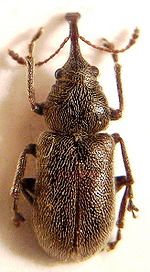 Weevils-
A weevil is any beetle from the Curculionoidea super family. They are
usually small, less than ¼ inch, and herbivorous. The rice weevil and
granary weevil are pests of stored grain and seeds. They develop inside
whole grain kernels as small, white, wrinkled, grub-like larvae. There
is generally no external evidence that the larvae have been eating and
growing inside the seed until after about one month when the adult
weevil chews through the seed coat and emerges. The adult weevils are
1/8th inch long and have slender, hard-shelled bodies that appear pitted
or scarred with tiny holes. They are brown to reddish brown in color.
The rice weevil has four faint yellowish spots on the back of the
abdomen. The granary weevil is uniformly colored with no spots. Weevils-
A weevil is any beetle from the Curculionoidea super family. They are
usually small, less than ¼ inch, and herbivorous. The rice weevil and
granary weevil are pests of stored grain and seeds. They develop inside
whole grain kernels as small, white, wrinkled, grub-like larvae. There
is generally no external evidence that the larvae have been eating and
growing inside the seed until after about one month when the adult
weevil chews through the seed coat and emerges. The adult weevils are
1/8th inch long and have slender, hard-shelled bodies that appear pitted
or scarred with tiny holes. They are brown to reddish brown in color.
The rice weevil has four faint yellowish spots on the back of the
abdomen. The granary weevil is uniformly colored with no spots. 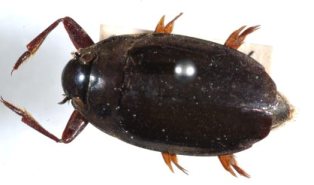 Whirligig
Beetle- The Whirligig beetle is greenish-black and flattened in
shape. It possesses long forelegs and very short mid and hind legs. The
Whirligig beetle seems to have four eyes, two above the water and two
below the water, but it really has two eyes that are split in half. This
beetle is found Swimming in groups on surface of quiet backwaters. This
beetle zips in wild patterns all around the surface of quiet water. When
disturbed it dives to the bottom. The whirligig beetle also protects
itself by giving off a strong smell like apple seeds. This beetle is a
scavenger, which means it eats dead plants and animals. Though it
prefers swimming, it can fly to a new home if the old one dries up. This
beetle is harmless, so don't be afraid the next time you are around it. Whirligig
Beetle- The Whirligig beetle is greenish-black and flattened in
shape. It possesses long forelegs and very short mid and hind legs. The
Whirligig beetle seems to have four eyes, two above the water and two
below the water, but it really has two eyes that are split in half. This
beetle is found Swimming in groups on surface of quiet backwaters. This
beetle zips in wild patterns all around the surface of quiet water. When
disturbed it dives to the bottom. The whirligig beetle also protects
itself by giving off a strong smell like apple seeds. This beetle is a
scavenger, which means it eats dead plants and animals. Though it
prefers swimming, it can fly to a new home if the old one dries up. This
beetle is harmless, so don't be afraid the next time you are around it. 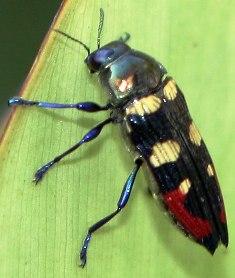 Metallic
Woodboring Beetle - Metallic wood-borers are so called because
adults of many species have a metallic luster, giving them a shiny
appearance while at rest. The name wood-borer refers to the larval
stage. Larvae bore under bark or deeper into heartwood of a variety of
tree species. The term "flat-headed wood-borers" is also used with these
beetles, and refers to the dorsally flattened appearance of the larvae.
Adults are quite active and quick to take flight when disturbed.
Activity generally occurs during the hottest part of the day, and
individuals may be seen sunning on logs or stumps. Many species also
occur on plants, and may be collected by beating foliage. Metallic
Woodboring Beetle - Metallic wood-borers are so called because
adults of many species have a metallic luster, giving them a shiny
appearance while at rest. The name wood-borer refers to the larval
stage. Larvae bore under bark or deeper into heartwood of a variety of
tree species. The term "flat-headed wood-borers" is also used with these
beetles, and refers to the dorsally flattened appearance of the larvae.
Adults are quite active and quick to take flight when disturbed.
Activity generally occurs during the hottest part of the day, and
individuals may be seen sunning on logs or stumps. Many species also
occur on plants, and may be collected by beating foliage. |
|
|
Advertise | Privacy Statement | Dog Encyclopedia | Video |Contact | Alaska Nature |
|